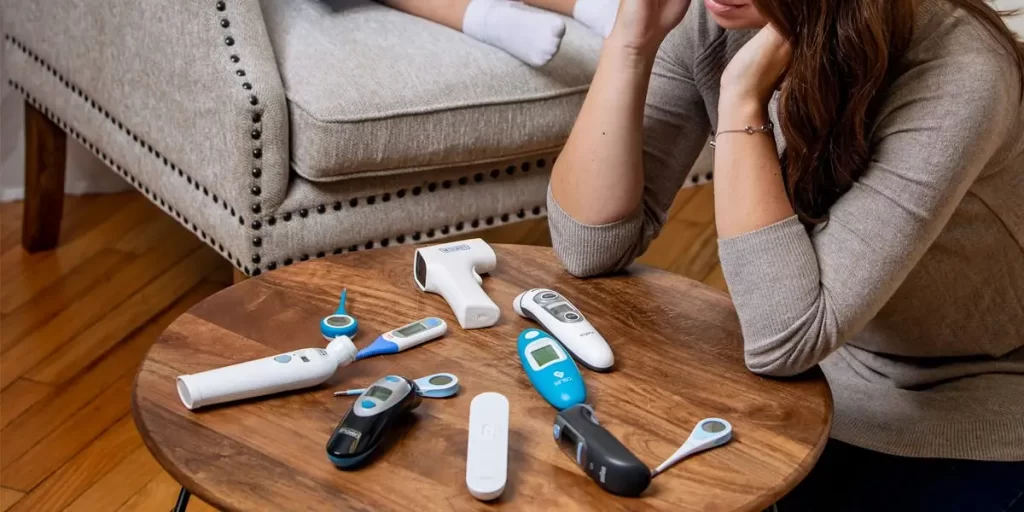Thermometers: Types, Uses, Pros and Cons
Eating a healthy diet, practising regular exercise, avoiding cigars and alcohol, using homeopathic remedies, etc, are all great ways to keep your body healthy. But sometimes, getting sick (like having a cold or flu) is inevitable. The body temperature tends to gravitate around 37°C when it’s healthy. When exposed to an illness or virus, the body temperature rises, resulting in a fever.
In cases like that, having a reliable medical thermometer at hand to check your temperature can be very helpful in treating an illness. Being able to determine whether or not you or someone in your family has a fever gives you important information about the next steps in your treatment.
Contents
Contact vs Contactless Thermometer – What’s the Difference?
Body temperature can be measured remotely or by making contact with the skin. Years ago, direct contact was the sole option, but technology has improved to the point that we can now monitor body temperature from a short distance as well. The contactless method has been shown to be more sanitary and to reduce the transmission of viruses and germs.
In other words, a contact device increases the danger of spreading germs to other individuals, but a contactless model reduces the risk because there is no direct touch with the surface of their skin. Getting a modern contactless thermometer means that it’ll only take only a few seconds to take a reading, while contact thermometers might take up to a minute.

It’s of extreme importance that you understand how your thermometer works. That is because not all types operate in the same manner or offer the same temperature readings. When someone is unwell, you don’t want to rely on guesswork. Below is an overview of different thermometers, how to use them and their advantages and disadvantages.
Infrared Thermometers
Commonly referred to as forehead thermometers, an infrared device is a type of contactless thermometer. It’s used in hospitals and households alike, slowly but surely becoming a go-to choice due to its reliability and ease of use.
An infrared thermometer monitors arterial heat as it travels through the temporal artery on the forehead. With its infrared scanning technology, a decent model can produce an accurate reading in 2-3 seconds.
This non-invasive thermometer takes temperature with a simple swipe across the forehead, making it suitable for individuals of all ages, from toddlers to the elderly. This innovative thermometer can save up to eight temperature readings and has a soft glow light for convenient viewing at night without having to undress and wake up your child. With all these features, this thermometer sure makes measuring temperature a breeze.
Types of Digital Thermometers
In steady conditions, digital thermometers (which have mostly replaced mercury thermometers) can deliver accurate readings in less than a minute. Readily available in local and online pharmacies, a digital thermometer can be used in three different ways.
Oral Administration
The thermometer is put under the tongue to measure the temperature in this way. This approach is suitable for adults and older children who are able to keep a thermometer in their mouth for a minute or two. However, keep in mind that this method of measuring temperature might be altered by a variety of circumstances, including whether the person has just eaten or drunk something hot or cold.

Underarm Administration
A thermometer is put under the crease of a person’s armpit to check the temperature. This procedure is useful for children and people who cannot maintain a thermometer in their mouth for an extended period of time, but it is also highly unpleasant. You will need to keep it in a specific posture for a longer period of time. This will undoubtedly be difficult for a little sick child.
Rectal Administration
The rectum’s temperature is measured by gently putting a thermometer into it. This procedure is most commonly used for newborns and toddlers. Aside from causing discomfort to a child, this method is also not considered safe.
Because it’s a bit invasive, a newborn should remain motionless and undressed for an extended period of time. This approach is highly unpleasant, and you must apply sanitary measurements because it is an intrusive method and the rectum contains a lot of bacteria.
Tympanic Administration
A tympanic (ear) thermometer detects infrared heat to determine the temperature within the ear. Because of its size, it is normally reserved for older children and is not advised for newborns under three months of age. The disadvantage of utilizing this thermometer is that it will not provide accurate readings if the youngster does not remain motionless.
You must be very careful when using this thermometer, making sure that it does not contact the child’s eardrum, since this can be uncomfortable and cause a lot of suffering. Needless to say, if a child has an ear infection, this thermo

















